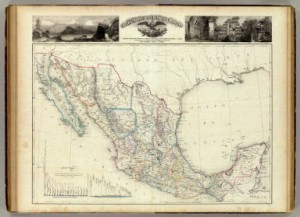 Craib, Raymond. 2004. Cartographic Mexico: A History of State Fixations and Fugitive Landscapes. Durham, NC: Duke University Press.
Craib, Raymond. 2004. Cartographic Mexico: A History of State Fixations and Fugitive Landscapes. Durham, NC: Duke University Press.
I remember my social studies teacher in elementary school using the peel of an orange to show us why most world maps distorted the size of countries near the poles. The revelation was particularly aggravating for me because it wounded my innocent nationalist pride: In the faulty world of maps, my country paled in comparison to mighty Greenland. I thought “What a rip!” Pointing out that maps are power-laden representations and documents, rather than impartial “scientific” renderings of inanimate realities has become de rigueur, but Raymond Craib proves much more in his book Cartographic Mexico. On one level, he conclusively demonstrates how maps and map-making have been key components of Mexican statecraft. His thesis would lend itself easily to facile characterizations of scheming, all-powerful state-makers dominating a passive, mostly peasant citizenry. Such an argument would be chalked up to what I call “smoke-filled-rooms” interpretations of history (such rooms of course sometimes are important in particular times and places).
Undeniably, that’s one dynamic at work in Craib’s account, but certainly not the only one. Craib shows how knowledge-based rule was being constituted during the rule of strongman Porfirio Díaz—three decades, known as the porfiriato—by both process (mapmaking) and product (map). Indeed, the strength of his story is that the state’s gathering of knowledge was not only a top-down endeavor, but also a “contested, dialectical, social (not merely technical)” (2) production of space in which the practices of campesinos, hacendados, cartographers, surveyors, explorers, and state-makers all played a role. Craib understands the deployment of maps and mapmaking, following Foucault, as a modality of rule produce by a complex assemblage of forces and relations.
Interestingly, the Spanish word for fixity (fijar), which Craib notes is a state obsession, can also mean, “to see,” which fits well with JB Harley’s suggestion that “cartographers manufacture power: they create a spatial panopticon. It is a power embedded in the map text” (13*). The map (inseparable from mapping) and the panopticon are powerful but somehow neutral instruments; by neutral I mean that they can be wielded by a variety of actors—even if that usually means the powerful. Craib describes how maps were raised in “the clench fists” of competing parties, while Foucault makes the point that the sovereign gaze of the panopticon can be wielded by whoever is standing in the central tower. He writes, “The disciplinary mechanism will be democratically controlled, since it will be constantly accessible to ‘the great tribunal committee of the world’” (D&P, 207).
But Craib’s focus on situated practices and their inherent ambiguities shows that for the Mexican state, knowledge is not as immediate or simple as looking out from a central tower at the backlit bodies of prisoners. In its effort to rationalize and demarcate property holdings, delimit administrative boundaries, whether motivated by taxation or extraction, or driven by the imperatives of military protection or foreign capital investment, the state’s “fantasy for fixity” is constantly coming up against the messy realities on the ground, where place-names are as fluid as the course of rivers (11).
Aware of this, government directives show mapping was as much about physical territorial inventory and demarcation as it was about “thick description” spatial ethnography, or what Craib calls, respectively, structured and situated knowledge (151). In the practice these two kinds of knowledge are inseparable, which explains why surveyors depended on knowledgeable locals; it is in the relay of these knowledges with the state that they apparently become divorced and refracted. Craib’s description of the social relations of map making bears striking parallel to the “human terrain” counterinsurgency strategies of the U.S. military. This top-down and bottom-up tension of state knowledge production is a constant tension in the story.
But in making this point, it seems like Craib left out a key piece of the story. Positivism—or logical positivism—is mentioned in passing or as an adjective only a few times in the book. Logical positivism was a powerful ideology that gripped state-makers across Latin America. In Cartographic Mexico it is only explicitly acknowledged in a footnote on the científicos, which are only referenced once in the context of post-revolutionary Mexico—that is, after the porfiriato (192). Maybe Craib decided that the subject has been beat to death in Latin American historiography, but it seems worth dwelling on considering the subject and arguments of the book.
Logical positivism was hugely influential throughout Latin America. “Order and Progress” is still stamped on the Brazilian flag. But nowhere was it more influential than in Porfiriato Mexico. The so-called científicos (scientists) were a cabal of capitalist technocrats appointed by Porfirio Díaz, who counseled the general (himself a positivist) to push education, medicine, foreign investment, and other projects to modernize Mexico. Not only did the científicos believe that science and empiricism were the basis of a liberal “art of governance,” they were convinced Comtean positivists that believed society was evolving through a series of progressive stages.
The importance of this ideology comes through in the concrete. Take, for example, the spatial restructuring of Yaqui and Mayo territory in the state of Sonora. Craib describes the rationale behind the restructuring in the following footnoted line: “Each lot granted to an Indian family would be located between lots put aside for ‘civilized people’—or ‘colonizers’—who would help ‘spur the Indians’ moral advancement’” (167). The footnote shows the quotes are from two letters: one written by Díaz and the other written by Sonora’s then-governor Ramón Corral, who was a radical científico leader that later served in Díaz’s cabinet as Foreign Minister and Vice President in the latter stages of the Porfiriato. Clearly, mapping and statecraft were heavily inflected by these positivist ideologies and ideologues.
This is a minor quibble with an otherwise excellent book; indeed, my favorite on mapping.
*Harley, JB. 1989. “Deconstructing the Map.” Cartographica 26(2): 1-20.
